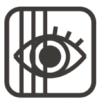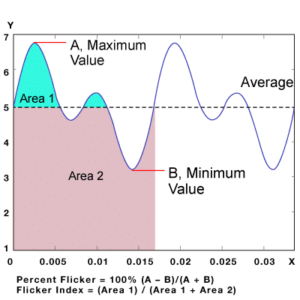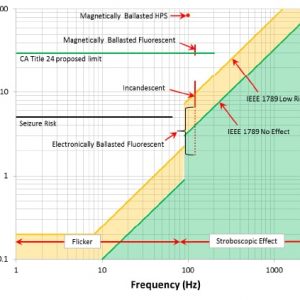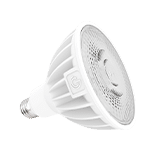
Flicker Free LED Lighting
When choosing an LED light, do you consider how flicker will affect your application? If not, please take a moment to learn about flicker and how it can impact your lighting environment.
What is Flicker and it’s Effect?
Flicker is the rapid variation in light intensity over time. Flicker may be visible, or imperceptible, depending on the intensity and speed of the variations.
Visible flicker is detected by the eye and consciously registered by our brains. Invisible flicker cannot be directly perceived by the human eye; however, we may still sense it. People who are sensitive to flicker may be unaware that their discomfort is caused by flickering light.
Although flicker in lighting is often not directly perceived by the human eye, it still causes problems such as eyestrain, headaches after prolonged exposure, more severe problems for sensitive people (e.g. seizures), distortion in video recording, interference with the operation of technical equipment (e.g. bar code scanners) etc. IEEE Std 1789-2015 explained more details and studies about the biological effects caused by flicker. [1]
Flicker in Various Applications
 For both general lighting and task lighting, lamps with reduced flicker are always preferable. Minimizing flicker is especially important where sensitive populations spend time, like hospitals, daycare centers, assisted living facilities, and classrooms. It is also recommended in areas where certain tasks or operations need to be performed safely and accurately, such as labs, warehouses, and industrial spaces. In the cases of video conferencing and laboratory video documentation, flicker free lighting is important to eliminate unwanted artifacts in the image capture and transmission. In offices and working environments, reduced flicker may lead to greater focus and higher productivity. Flicker free lighting may help students retain lessons by promoting concentration. In industrial working environments, flicker-free LED lights eliminate the strobing effect, reducing dangers around high-speed machinery. In warehouses, reduced flicker ensures sensitive scanning equipment operates without disruption. Refer to IEEE Std 1789-2015 for more information regarding published research and/or Expert Opinion that identified the above mentioned major and minor adverse effects of flicker.[1]
For both general lighting and task lighting, lamps with reduced flicker are always preferable. Minimizing flicker is especially important where sensitive populations spend time, like hospitals, daycare centers, assisted living facilities, and classrooms. It is also recommended in areas where certain tasks or operations need to be performed safely and accurately, such as labs, warehouses, and industrial spaces. In the cases of video conferencing and laboratory video documentation, flicker free lighting is important to eliminate unwanted artifacts in the image capture and transmission. In offices and working environments, reduced flicker may lead to greater focus and higher productivity. Flicker free lighting may help students retain lessons by promoting concentration. In industrial working environments, flicker-free LED lights eliminate the strobing effect, reducing dangers around high-speed machinery. In warehouses, reduced flicker ensures sensitive scanning equipment operates without disruption. Refer to IEEE Std 1789-2015 for more information regarding published research and/or Expert Opinion that identified the above mentioned major and minor adverse effects of flicker.[1]
Flicker in your lighting environment matters more than you may think. Choosing an LED with less flicker will improve performance in almost any lighting solution.
Flicker in LED Lighting
Unlike other lighting sources such as incandescent lamps which will not stop glowing right after the lamps switched off, LEDs respond immediately to the supply of current. In the US, electricity is delivered via alternating current (AC) at a frequency of 60Hz. The voltage supplied to a lighting source bounces rapidly between “on” and “off” in a sine waveform. As a result, the LED light source will be driven to produce alternating light output, or flicker, at a frequency of 120Hz, twice that of the power grid’s frequency. This is why most LED lights come with their own electronic circuitry: an LED driver. Quality driver in superior system design regulates the current and ensures that LEDs produce a constant state of light. While inferior driver design cannot guarantee the system performance and allow flicker.
Flicker Metrics
Two simple and common metrics used to measure flicker are Percent Flicker (PF), also known as modulation depth, and Flicker Index (FI).
Percent Flicker (PF) is a commonly used method for quantifying flicker as a percentage. It refers to the amount of flicker at a given frequency, also known as peak-to-peak contrast.
Flicker Index (FI) is defined as the area above the line of average light divided by the total area of the light output curve for a single cycle.

However, Percent Flicker or Flicker Index alone does not determine whether you will perceive the flicker effect from a lighting system. Flicker frequency—the rate at which the light output fluctuates at a given time—also determines whether flicker is observed or sensed.
For most people, flicker at a frequency of less than 80Hz is perceptible. When the frequency is higher than 80Hz it is usually unnoticeable, thus becoming invisible flicker, and may cause a stroboscopic effect for objects moving at a high speed.
IEEE (The Institute of Electrical and Electronics Engineers), outlines the various risk levels associated with flicker frequency and sets a standard for acceptable ranges in IEEE P1789. As shown here in the graph, the green region represents “no observable effect” while the yellow region represents a low risk of health effects due to flicker.

In addition to Percent Flicker and Flicker Index there are additional metrics to communicate more information. See below table for a quick overview and comparison.
Flicker Metric | Description | Introduced by | Adopted by | Acceptance Criteria | Pros & Cons |
Percent Flicker(PF) | A relative measure of the cyclic variation in the amplitude of a light. | Illuminating Engineering Society (IES) | IEEE Standard 1789 | Divides light modulation vs. frequency (1-2000Hz) into areas: “No effect”, “low risk" | Easy to understand and calculate. |
California Title 24 requirements | <30% at frequencies less than 200Hz | ||||
Energy Star | Report only | ||||
Flicker Index (FI) | A measure of the cyclic variation in output of a light source taking into account the waveform of the light output. | Illuminating Engineering Society (IES) | Energy Star | Report only | Easy to understand. |
Stroboscopic Visibility Measure (SVM) | Time domain → frequency domain. | PHILIPS & CIE [2] [6] | NEMA 77 [5] | <=1.6 | Based on human perception trials. |
Energy Star | Report only | ||||
Short Term Flicker Indicator (Pst) | The flicker severity evaluated over a short period (minutes). | IEC/TR 61547-1 [3] | NEMA 77 | <=1.0 | Quantify visible flicker <80Hz. |
Energy Star | Report only | ||||
ASSIST Flicker Perception (MP) | An objective method to assess the perception of flicker directly observed from light sources recommended by ASSIST. | RPI LRC Assist [4] | Energy Star | Report only | Similar to Pst in terms of values and dependence on frequency. |
Regulating Flicker in LED Lighting
LED flicker is generally caused by inferior driver designs. For dimming products, the incompatibility between LED products and the existing dimming systems can also cause flickering result.
In order to avoid flicker after installation of any LED lighting products in your project, it is worthwhile to check whether your LED lighting manufacturer offers flicker-free products. In case of dimming needed, you should also check the dimmer compatibility list published by most manufactures to ensure your existing dimming systems are compatible with the new products before installation.
Flicker free LED lamps from GREEN CREATIVE are designed with proprietary LED driver for eliminating flicker effect and ensure quality lighting result for various applications.
GREEN CREATIVE Flicker-free products: Percent Flicker ≤5% at frequencies less than 200Hz
GREEN CREATIVE Low-flicker products: Percent Flicker <30% at frequencies less than 200Hz
References |





